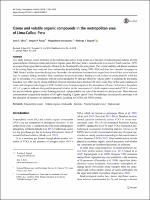Ozone and volatile organic compounds in the metropolitan area of Lima-Callao, Peru
Fecha
2018-07-26Colecciones
- Artículo científico [176]
Resumen
This study analyzes ozone formation in the metropolitan area of Lima-Callao as a function of meteorological patterns and the concentrations of nitrogen oxides and reactive organic gases. The study area is located on the west coast of South America
(12°S) in an upwelling region that is markedly affected by the Southeast Pacific anticyclone. The vertical stability and diurnal
evolution of the mixing layer were analyzed from radiosondes launched daily during 1992–2014 and from two intensive
campaigns in 2009. Vertical profiles show that during June–November, the subsidence inversion base ranges from 0.6 to 0.9 km above sea level (asl). In contrast, during December–May, subsidence inversion dissipates, leading to weak surface inversions
from 0.1 to 0.6 km asl. At the surface level, compliance with the ozone standard of 51 parts per billion by volume (ppbv) is explained by the marine boundary layer effect and by strong inhibition of ozone formation due to titration with nitric oxide. Day-of-the-week variations in ozone and nitrogen oxides suggest a VOC-limited ozone-formation regime in the atmosphere of Lima. Furthermore, the pattern of C6–C12 species indicates that gasoline-powered vehicles are the main source of volatile organic compounds (VOCs), whereas the species with the greatest ozone-forming potential corresponded to the sum of the isomers m- and p-xylene. Mean benzene concentrations exceeded the standard of 0.63 ppbv, reaching 1.2 ppbv east of Lima. Nevertheless, the cancer risk associated with the inhalation of benzene was deemed acceptable, according to USEPA and WHO criteria.
El ítem tiene asociados los siguientes ficheros de licencia:








